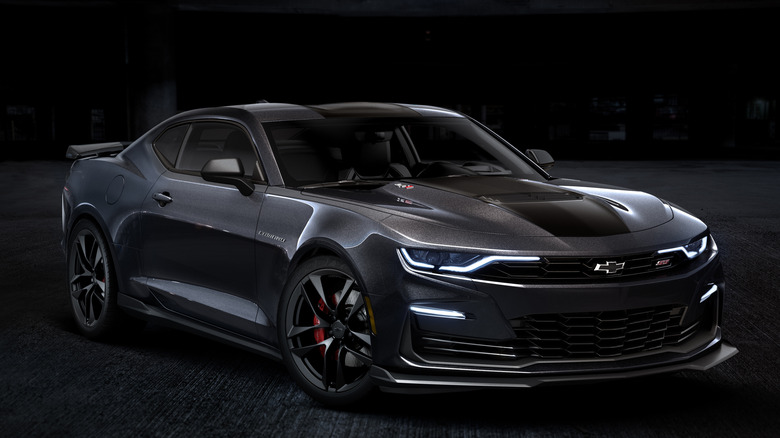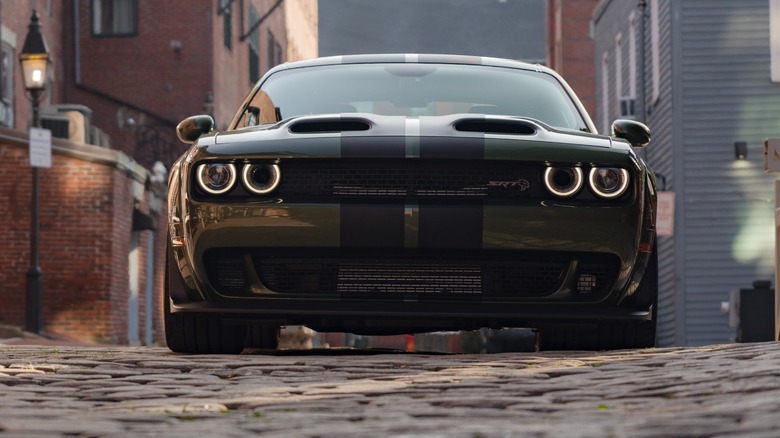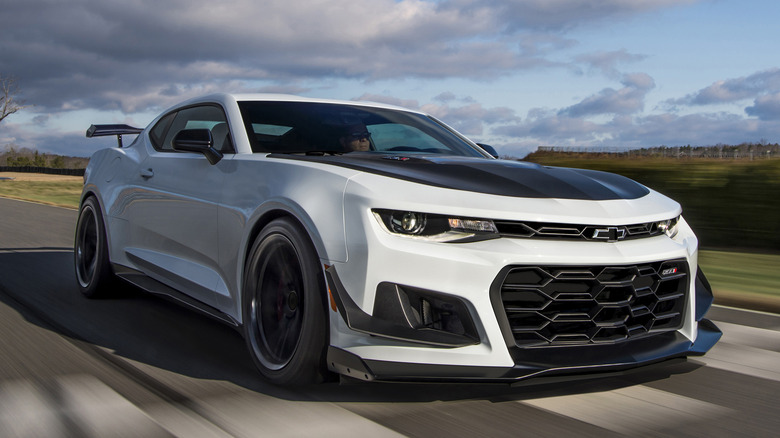Chevy Camaro ZL1 Vs. Dodge SRT Hellcat: Is The Supercharged LT4 Or The HEMI Faster?
The Dodge Challenger and the Chevrolet Camaro are decades-old rivals that held on to their supercharged V8s for as long as possible, battling it out for 0-60 supremacy and maximum muscle-car cred for quite some time. Unfortunately, the Challenger SRT Hellcat has gone the way of the dodo, being discontinued in 2023 and the supercharged Camaro ZL1 isn't far behind it. The Camaro ZL1 is sending things off in style with a special Collector Edition model as production ends in 2024, but if you haven't got your hands on one yet, it's probably too late. Supercharged V8 muscle cars haven't gone extinct just yet, but they're nearly there.
When they were both in production, however, these two ultra-powerful muscle cars were an excellent match when it came to horsepower, acceleration, and top speed. They competed for the hearts and hard-earned dollars of Americans, offering big V8 punching power in somewhat-affordable packages. But which one was faster? The Camaro boasts a number of racetrack-ready features like the 1LE Extreme Performance pack, but the Challenger has an advantage when it comes to horsepower. Does sheer power win out? Or will a focus on overall performance take home the trophy? Let's find out.
Challenger SRT Hellcat is a superfast contender with lots of variants
The Challenger SRT Hellcat is powered by a supercharged 6.2-liter V8, and it uses rear-wheel drive. In Car and Driver testing, the Challenger SRT Hellcat Redeye Widebody accelerated from 0-60 mph in just 3.7 seconds. That's astonishingly fast when you consider its as-tested weight of 4,514 pounds. The Redeye is, however, one of the most powerful versions of the Challenger Hellcat. Standard Hellcat models debuted with 707 horsepower, but the Redeye checks in at 797 hp. All that power and the Hellcat Redeye blasts past the quarter mile in 11.8 seconds at 125 mph. Not bad for a car that weighs over 2 tons.
Of course, there are higher-horsepower versions of the Challenger worth noting, and other vehicles that use the Hellcat powertrain. The 6.2-liter Hellcat engine was used widely across the Dodge lineup in vehicles like the 2025 Durango SRT Hellcat Hammerhead — 0-60 in 3.5 seconds — and the four-door Charger, but the Challenger is a much more direct competitor for the Camaro. The Challenger Demon 170 is also a great example of a Hellcat that's not really a Hellcat. It's got a 6.2-liter supercharged V8 under the hood, but all of its primary engine components are unique — Dodge says the only untouched component is the crankshaft. Yes, it can blast from 0-60 mph in a scarcely-believable 1.66 seconds, but it requires drag radials and special fuel to get there, so it's not exactly a direct competitor for the Camaro.
Chevy's LT4-powered Camaro ZL1 means business
Like the Hellcat, the Camaro ZL1 uses a supercharged 6.2-liter V8. The Camaro's V8 is called the LT4, and it produces 650 horsepower – less than the standard Hellcat, much less than the Redeye, and only slightly more than half of what the Demon 170 puts out. The Camaro, however, is much lighter than the standard Hellcat. Tested versions of the ZL1 have tipped the scales at a scant 3,886 pounds –over 600 pounds lighter than the Redeye. On the drag strip, that means a faster time out of the gate. When Car and Driver tested the ZL1, it went from 0-60 mph in just 3.4 seconds. The quarter mile was done away with in just 11.5 seconds at a speed of 124 mph.
In a straight fight, the Camaro ZL1 wins against a standard Hellcat (even some of the further souped-up ones), providing you get the launch right in both vehicles. If you let the Challenger have its special-edition models lineup at the lights, it's a very different story, but that's part of the fun. Muscle cars like the Camaro and the Hellcat (and let's not forget the most powerful engines put in the Ford Mustang) have been locked in these kinds of battles for years and even though the supercharged-V8-years are on their way out, we hope the battle for speed supremacy never ends.


